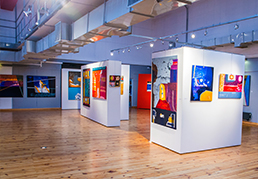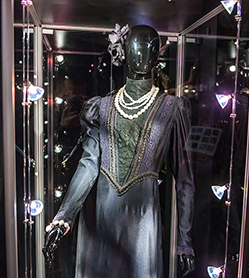Wystawy
Vernissage of the ‘Curved Cirlce’ Exhibition 22.02-27.03.2019
The Curved Cirlce Exhibition will last until March 27, 2019.
We invite you to the vernissage on February 22 at 19:00.
Presentation of the Krzywe Koło (Curveed Circle ) Gallery (1956-1965). Works on paper is an extended version of the exhibition prepared in Radom. Among the many proposals of Marian Bogusz (1920-1980), the idea of creating a publicly accessible collection of works of modern art stood out, following the example of the International Collection (1931) organized by Władysław Strzemiński and deposited in the Łódź museum. The artist began to prepare this project immediately after his release from the Mauthausen concentration camp (1945) and the establishment of the Young Artists and Scientists Club in Warsaw (1947). Political supervision of art and the doctrine of socialist realism stopped further collection. It was only the opportunity to speak freely on even the most sensitive topics that followed the transition after 1956, meetings and discussions of intellectuals at the Crooked Circle Club in Warsaw, organizing exhibitions at the autonomous Gallery run by Bogusz (1956), created conditions for returning to these assumptions. Bogusz collected works by artists exhibiting at the Krzywe Koło Gallery, combining the achievements of artists from various regions of Poland, with authors from the Czech Republic, Slovakia, Hungary and Germany, as well as the international Phases movement. He wanted to gather a constantly exposed, constantly expanding collection.
Presentation of the Krzywe Koło Gallery (1956-1965). Works on paper is an extended version of the exhibition prepared by the Warsaw Space for Art S².
The International Collection of Modern Art at the Krzywe Koło Gallery dispersed in private collections.
Among the many proposals of Marian Bogusz (1920-1980), the idea of creating a publicly accessible collection of works of modern art stood out, following the example of the International Collection (1931) organized by Władysław Strzemiński and deposited in the Łódź museum. The artist began to prepare this project immediately after his release from the Mauthausen concentration camp (1945) and the establishment of the Young Artists and Scientists Club in Warsaw (1947). Political supervision of art and the doctrine of socialist realism stopped further collection. It was only the opportunity to speak freely on even the most sensitive topics that followed the transition after 1956, meetings and discussions of intellectuals at the Crooked Circle Club in Warsaw, organizing exhibitions at the autonomous Gallery run by Bogusz (1956), created conditions for returning to these assumptions. Bogusz collected works by artists exhibiting at the Krzywe Koło Gallery, combining the achievements of artists from various regions of Poland, with authors from the Czech Republic, Slovakia, Hungary and Germany, as well as the international Phases movement. He wanted to gather a constantly exposed, constantly expanding collection. Initially, he held talks with the Museum of Art in Łódź. At that time, a group of 13 paintings (among others: Jerzy Kujawski, Roberto Matta Echaurten, Karl Otto Gőtz) was gathered in Paris, which received the Łódź museum. Director Marian Minich, however, rejected the project of the existence of a separate collection of artists that could be the beginning of the future Museum of Modern Art.
Established in 1957-1961 so-called The 1st Collection of the Krzywe Koło Gallery, consisting of 35 paintings (among others: Henryk Stażewski, Stefan Gierowski, Marian Bogusz, Kajetan Sosnowski), was donated to the National Museum in Warsaw (1963), but it was not exhibited there.
In the sixties Koszalin became the main place of Bogusz’s creative activity. The first exhibitions of modern art took place at the Baltic Dramatic Theater, where the artist took the position of the Main Theater Artist, and then at the local museum. It was in Koszalin that Bogusz hoped to create a Museum of Modern Art, for which he donated (in 1963) Collections II – 13 paintings (among others artists from Czechoslovakia: Josef Istler, Mikuláš Medek, Aleš Veselý); and Collection III – 29 gouaches, drawings and graphics (among others: Maria Ewa Łunkiewicz, Jerzy Skarżyński, Andrzej Wróblewski, Rajmund Ziemski). The annual museum and artists’ meetings in Osieki near Koszalin (since 1963) were to ensure the development and scientific base of the future museum, to which artists from Czechoslovakia and Hungary were also invited. The condition of participation in the meetings was to donate one of the works to the existing collection of paintings and drawings in the museum.
In 1965, the implementation of the Bogusz project was interrupted. By decision of the provincial office, the art department was closed in the Koszalin museum. The Museum of Modern Art in Koszalin, organized from June 1963, ceased to exist, the collection was transferred to the Museum of Central Pomerania in Słupsk. Bogusz’s carefully selected paintings, gouaches, watercolors, drawings and photographs were also not exhibited in this museum, they got stuck in museum magazines. Very rarely and only some of the works out of context were shown at temporary exhibitions.
A fully successful Bogusz initiative supporting popularization.
Janusz Zagrodzki
 return
return








